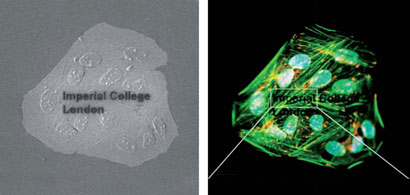
Posted on 05/01/2012 5:14:17 PM PDT by neverdem
A UK based team has combined two methods into a new technique to investigate cell-substrate interactions in biomedical research.
The new technique, correlative light-ion microscopy (CLIM), combines both ion and fluorescence microscopy to obtain topographical and biochemical information for the same area of a sample.
The idea for the technique came to Molly Stevens and her colleagues at Imperial College London, when they observed unknown structures while conducting characterisation tests on human tissue samples. 'We realised that there was no simple and efficient method to correlate structural and biochemical information at the micro and nanoscale. Therefore, the only way forward was to ingeniously combine our available technology and expertise in order to develop a new imaging method,' she says.
Scanning electron microscopy (SEM), which provides structural information, normally requires the sample to be dried and coated with a protective layer, while fluorescence microscopy - used to obtain biochemical information - usually needs the sample to be hydrated. The two techniques would appear to be mutually exclusive, or at the very least time consuming to correlate if run separately.

|
Both SIM (left) and fluorescence (right) microscopies can be performed on the same sample
|
The new method works because instead of SEM, scanning ion microscopy (SIM) is used. This involves a beam of gallium ions instead of electrons, which does not interfere with the fluorescence signal, a problem with traditional SEM. Non-contradictory sample preparation also means that both tests can be run on the same sample.
'I believe that the developed approach is a major breakthrough in the field as it generates new and useful information that is otherwise difficult to obtain,' comments Ali Khademhosseini, from Harvard Medical School and Brigham and Women's Hospital, US, who studies micro and nanoscale technologies to control cellular behaviour. 'I anticipate its widespread use in many biological applications where both SEM and fluorescence are needed.'
Stevens believes the work can be helpful across many fields including biotechnology, biomaterials and cell biology, particularly when looking at in situ cell interactions. 'Considering that fluorescence microscopes can be found in virtually any laboratory and scanning ion microscopes are more and more common, CLIM may well find very wide applicability in biomedical laboratories,' she says.
S Bertazzo et al, Nanoscale, 4, 2851 (DOI: 10.1039/c2nr30431g)
This is great for structural cell biology. I can’t wait to see how this works on neurons!
Correlative light-ion microscopy (CLIM), certainly sounds cool for dynamic imaging.
Really interesting idea.
I feel like the Europeans have pushed the R&D gas pedal to the floor in the last 5-7 years.
Is that actually the case?
Or do we just see their names more because the Internet pulls in so much foreign news?
Not so long ago EVERYTHING I read on physics, astronomy, quantum computing, and instrumentation was linked to a USA research lab or university.
Disclaimer: Opinions posted on Free Republic are those of the individual posters and do not necessarily represent the opinion of Free Republic or its management. All materials posted herein are protected by copyright law and the exemption for fair use of copyrighted works.